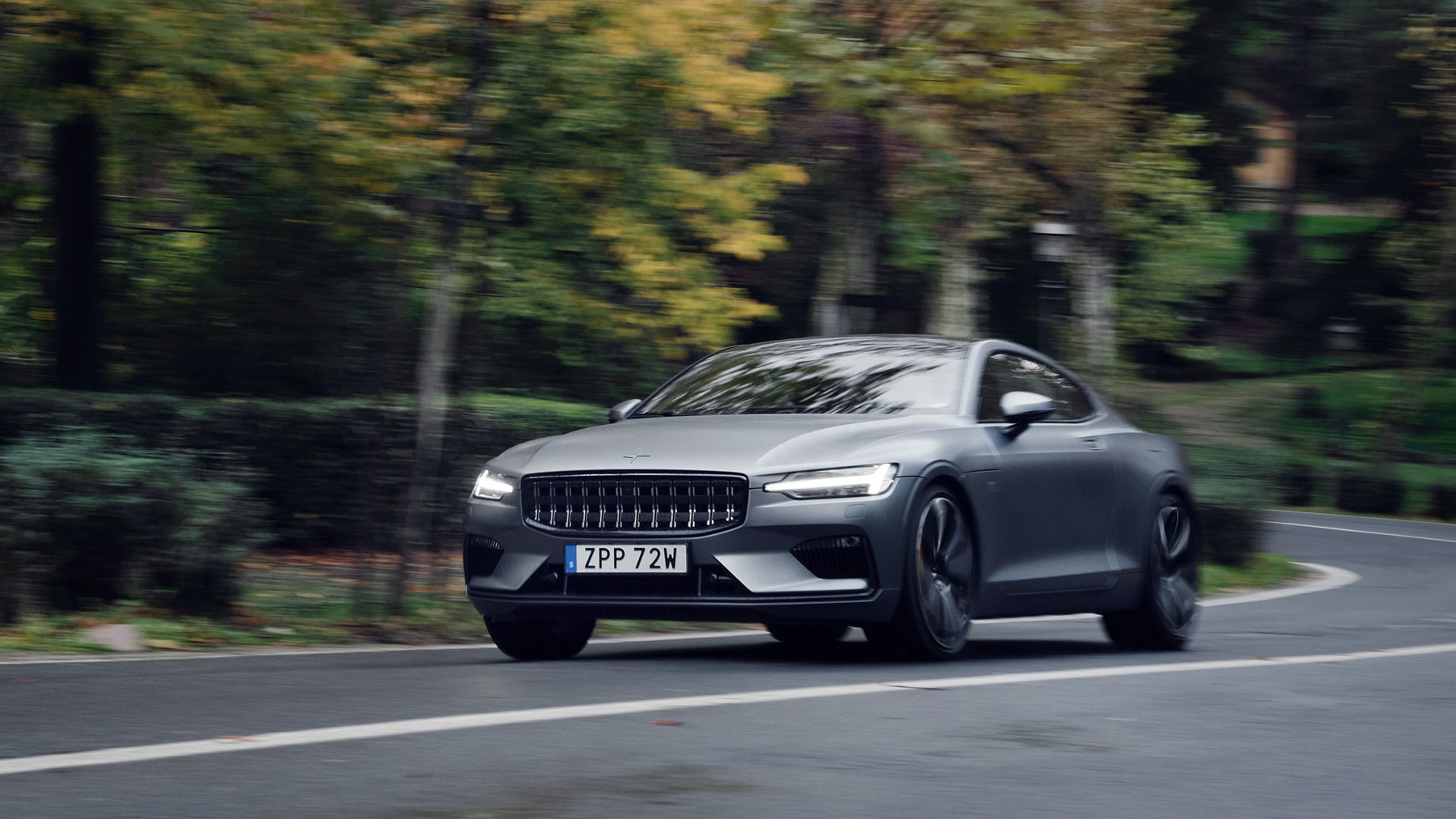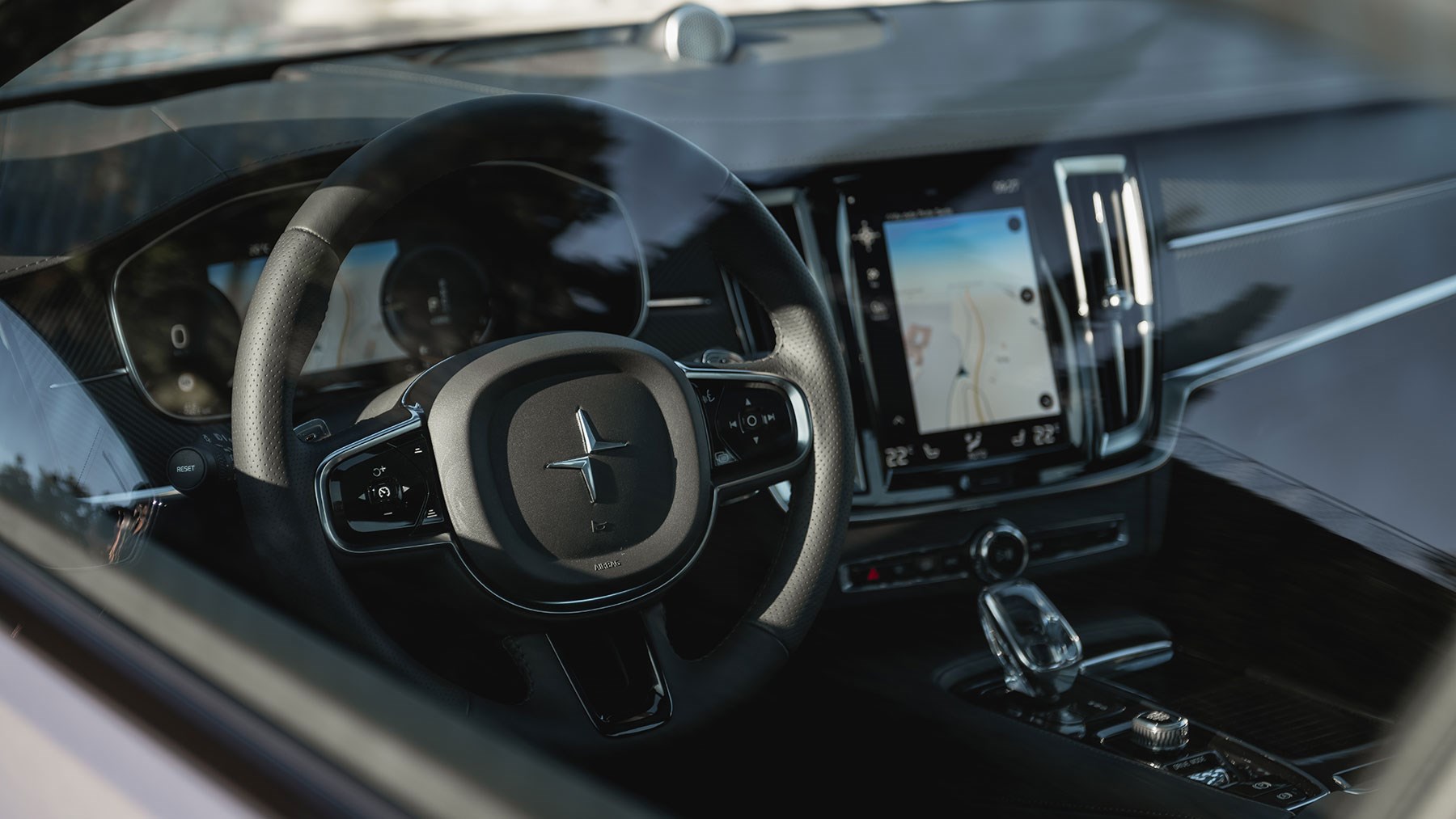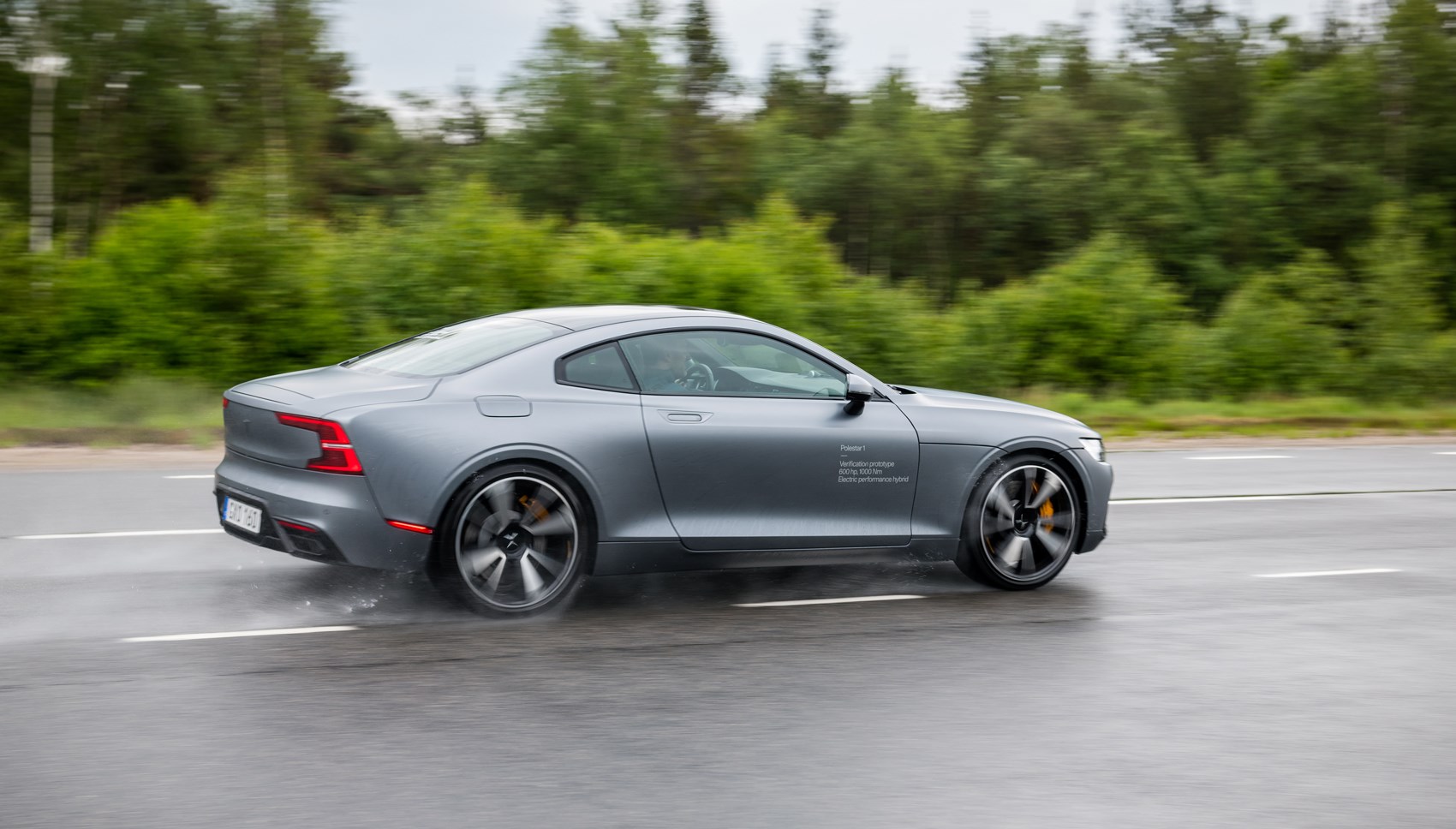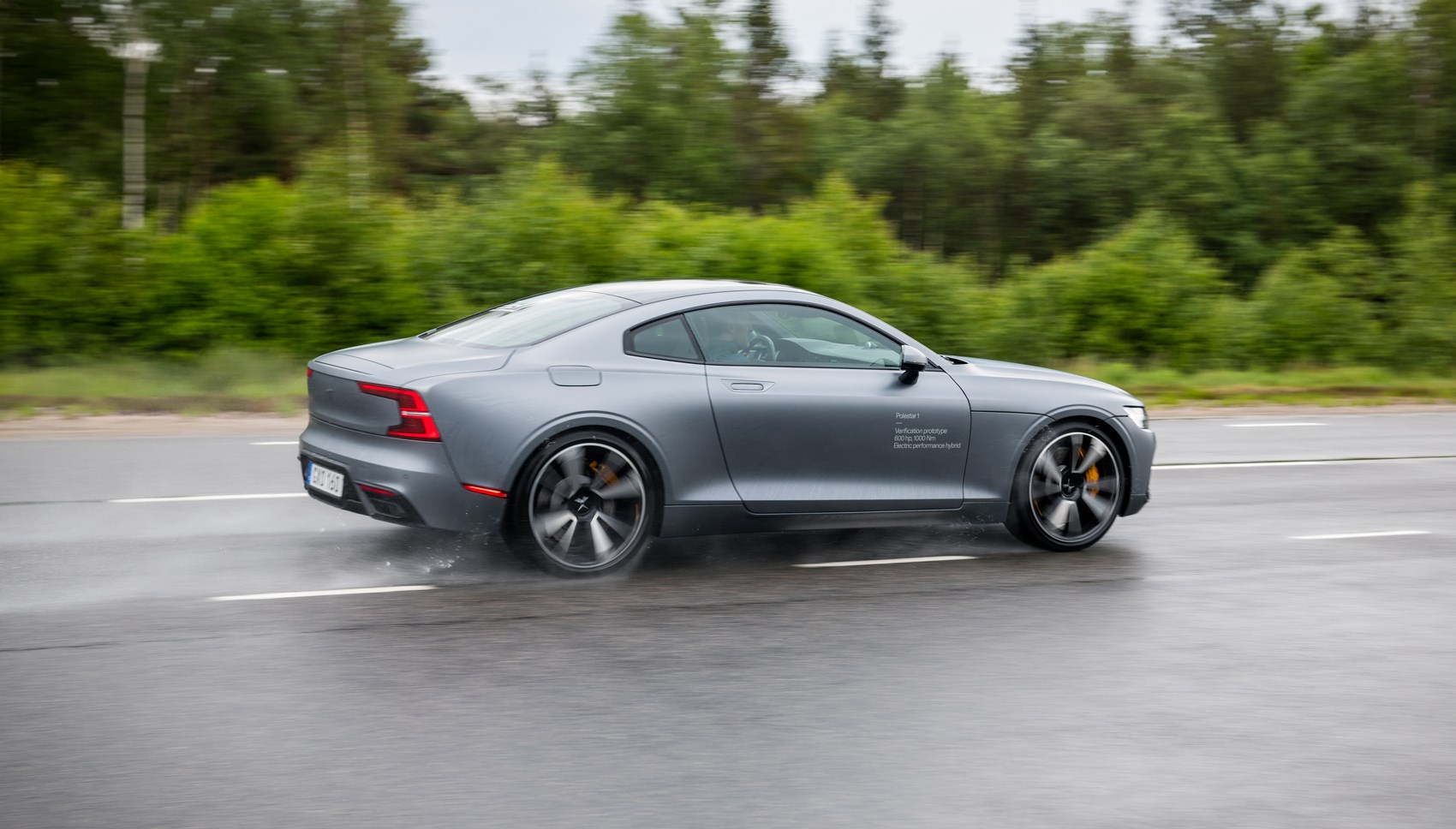► First drive of new Polestar 1
► Volvo’s new premium EV brand
► Plug-in hybrid GT targets BMW, Bentley
So, for the sake of those who may be confused, what exactly is Polestar? First and foremost, it is a brand new Swedish high-end electric car maker bankrolled by Geely, built in China and backed by Volvo. It’s also, a tad confusingly, the badge used on performance versions of mainstream petrol and diesel Volvos. A Swedish motorsport team that races Volvos is also called Polestar. Finally, and most relevant to our tale, it’s the badge on an impressive new plug-in hybrid GT that looks like a top-end Volvo coupé but goes more like an Aston Martin. Welcome, Polestar 1.
So what sort of car is Polestar 1?
It’s a very handsome 2+2 carbon fibre-bodied £139,000 grand tourer, and it’s Polestar’s first car. All future Polestars will be pure electric, beginning with the Polestar 2, a Tesla Model 3-rivalling saloon on sale mid next year.
So why, then, is the first Polestar, as tested here, a plug-in hybrid? CEO Thomas Ingenlath wanted a handsome flagship to launch the brand. It has an unusually long range for a PHEV (78 miles), so it’s not your usual cynical plug-in hybrid designed to beat emission and tax regulations rather than serve up proper emissions-free EV driving. Ingenlath, Volvo’s former design director and the man responsible for transforming Volvo’s style, felt this duly ticked the electric car box. After all, it’s got the best electric range of any plug-in hybrid on sale.
Plus, the design was already done, dusted and much-admired. The Polestar 1 is a production version of the delightful Volvo Concept Coupé show car of 2013, which first previewed Ingenlath’s new Volvo design language. It may be six years old. But it certainly doesn’t look it.

It was also relatively easy to engineer and tool. The 1 rides on the familiar SPA platform as used on bigger Volvos, although shortened in wheelbase and in rear overhang (and carbon reinforced to boost rigidity by 60 percent). The mechanicals are a heavily modified (especially in electrification) version of Volvo’s XC90 T8 ‘twin engine’ powertrain. It includes the turbo- and supercharged 2.0-litre four-cylinder petrol engine and eight-speed auto ’box.
The dashboard, including big upright central touchscreen, is also familiar Volvo ware. So is the steering wheel and switchgear. Note, also, those trademark Thor-hammer head lights, Volvo-shaped grille and Volvo-like rear lamps.
So what’s non-Volvo about it?
No production Volvo looks this sleek, and no other Volvo has a lightweight all-carbon body, saving 230kg if we include the changes to the SPA platform. The body is exquisitely finished, the creases crisp and sharp. The big single-piece clamshell bonnet is a work of industrial sculpture and means no unsightly shutlines. The powertrain is much changed over the usual XC90 T8 Volvo, too. On the Polestar we find three electric motors including two – one per wheel – on the rear axle to enable exact torque delivery including torque vectoring for more precise handling and greater agility. Maximum power – petrol plus electric – is 600bhp, so it’s way more powerful than any road Volvo.
Other significant non-Volvo touches include a fully mechanical suspension – so no push button electronic adjustment between sport and comfort – and no mushy air springs, either. In fact, the 1 has track car-like mechanically adjusted Ohlins dampers. And, yes, you can adjust then manually (there are 22 settings) to make them stiffer/softer.
The fronts are simple to adjust. Just open the bonnet and twirl the settings on the damper turrets. For the rear, you’ll need a trolley jack to get access to the adjusters. I doubt whether any manual adjustment will ever take place, or be necessary. The settings offer a superb balance between ride and handling. The other really top-end components are the Akebono brakes, as used on the McLaren P1. They are cast iron, not carbon ceramic, but fabulous all the same.

The buying experience is also very non-Volvo. There are no dealers, just Polestar Spaces in certain city centres (Beijing and Oslo now open, London and a few other UK sites to come). Buying will be done on-line and will mostly be via monthly subscriptions including maintenance and insurance. On the 1, there is no base model and no big options list. The best equipment is fitted as standard. There are five exterior colours, in matte or gloss, three wheel finishes, the brightwork can be chrome or glossy black, and there are two shades of Nappa leather seats. That’s it.
How does it drive?
Like no Volvo, that’s for sure, as 0-62mph acceleration in 4.2 seconds suggests. Plus, there’s 738lb ft (or 1000 Nm in metric money) of torque. That means serious muscle, felt especially keenly in acceleration out of tight corners.
There’s a choice of five powertrain settings, from Hybrid (the default setting, that prioritises electric power unless big performance is needed), Pure (electric power only), Power (both engines engaged), plus Individual and All Wheel Drive (AWD) modes.
We start in Hybrid. Driving in Italy, and driving keenly but not aggressively on a mix of urban roads, autostrada and winding mountain roads, the car stayed in electric mode continually. Performance is sweet and strong, and 100mph is possible. What’s more, we did 65 miles of spirited driving without a whisper from the petrol engine. That’s not quite the claimed 78-mile range but, in gentler ‘normal’ driving, that range seems eminently believable.
Engage the Power mode and it feels 600bhp fast. The powertrain cycles seamlessly between electric and petrol drive, and the throttle response, assisted by the instant-torque electric motors, is excellent. It’s not quite as sporty and engaging as the lighter and smaller Aston Vantage, but the finely sorted suspension delivers a delicious blend of comfort and precision. Body control is outstanding.
Plus, it feels much sharper than its 2350kg kerb weight would suggest. That’s heavier a Bentley Continental GT. Blame the twin engine powertrain and the big bank of batteries. The low centre of gravity helps. After all, most of the battery weight is down low, and there’s a light and low carbon body on top. It’s also more engaging and alert than the big Bentley. The steering is light and lacks feel but the sharpness and precision of the Polestar 1, on winding Tuscan roads, was highly impressive. So too was its relaxed autostrada gait. It is an outstandingly brisk and highly refined GT, comfortable if not Bentley cushioning and cossetting. The only refinement complaint is the slightly groaning four-cylinder petrol engine. The Polestar 1 is actually more impressive as an EV. Which bodes well for future Polestars.

Seating comfort is excellent. No surprise there, as Volvo probably makes the best seats in the car industry. The rear pair, though beautifully trimmed, are for small children only. The boot, too, is small. Blame the rear battery pack, just over the rear axle. Intriguingly, you can see it – through a glass screen – when you open the bootlid.
Can a ‘Volvo’ be worth £139,000?
It’s true the cabin is Volvo-familiar, so you’re sharing a lot of hardware with a £30,000 S60. But then the top-end 8-series has a BMW-familiar cockpit, too. And Volvo makes nicer cabins than BMW. The same goes for same-money Benzes. Add some distinctive Polestar touches such as the seat trim, the exquisitely finished carbon body, the clever powertrain – and even the colour co-ordinated gold seat belts, brake calipers and tyre valve caps – and it’s clear the Polestar is way more than just a fancy two-door Volvo.
Plus, this Polestar will be a rare car: only 1500 will be built over a three-year production run. It’s also, at least to my eyes, the handsomest GT around, clean and exquisitely proportioned. Sadly for UK buyers, all will be left-hand drive.
The Volvo familiarity should also reassure Polestar 1 buyers that they’re getting all of the Swedish company’s safety, technical and quality expertise. Not too many start-up car makers can offer that.
Polestar 1: Verdict
This is a handsome and exquisitely finished car that offers a fresh and more modern alternative to lower-end Aston Martin and Bentley grand tourers, and top-end two-door BMWs and Benzes. Its excellent electric-only range means it’s both a convincing EV and a satisfying and highly desirable new petrol-electric performance GT.
Our earlier first drive of the Polestar 1 prototype
CAR’s earlier Polestar 1 review was of a prototype pre-production car. Read on for Jake Groves’s first impressions from June 2019.

We’ve waited a while for this. Polestar’s first fully-fledged car is nearing completion, and CAR was given special access to one of its pre-production cars both on road and at Volvo’s proving grounds near Gothenburg.
You’ll probably know all about the 1 by now, but here’s a recap; it’s a two-door GT car with a 592bhp (600 metric horsepower) hybrid drivetrain and all-wheel drive nestled underneath a crisp and clean design. A design that owes most of its handsome cues to the Volvo Concept Coupe of 2013.
The best hybrid cars
Joakim Rydholm, Polestar’s chief test driver, all-round good guy and a man filled to the brim with pride about something he’s spent years bringing to fruition, told us ‘the Polestar 1 is meant to do everything. It’s meant to be something you can use every day.’
Orders have opened in several markets for the new Polestar 1, with deliveries starting towards the end of 2019. In the UK, buyers will have to stump up £139,995 for one.
I’m sorry, how much?!
Yes, we wanted to get that out of the way first. You can get a very well-specced Porsche 911, an Audi R8 V10 Performance or a Mercedes-AMG S63 Coupe for the same amount of wedge. The 1 is also left-hand drive only.
That price tag does obviously account for extensive development work, the complicated hybrid powertrain and the fact that getting the car off the ground and making Polestar a car maker in its own right is rather costly. The car itself is loaded with kit, with the only cost option being matte versions of the paint colours available. Trimmings, wheel types and upholstery colours are all no-cost choices.

Even so, Polestar seem quietly confident that there plenty of people who have already put their name down for one and that others will be waiting. Given its high price tag, the brand is even considering scrapping the subscription service for the 1, at least in the US, as the kind of punter ordering one is already pretty wealthy, therefore doesn’t really need a pay-monthly scheme.
So, how does the Polestar 1 drive?
Well, first of all, it was rather wet when we drove it. Axel Stenberg, our passenger and the man who just so happens to be the Concept Lead for Polestar 1 (and also helped develop Volvo’s PowerPulse engine system), told us that Volvo’s proving grounds were inadvertently built in one of the wettest places in Sweden. Which is saying something.
Our first experience was on the way to the proving grounds, on a mix of roads including motorways and bumpy, twisty and tree-lined country roads. At a cruise, it’s familiar inside to anyone who’s driven or owns a recent Volvo; the Polestar uses an almost identical cockpit complete with Sensus infotainment, a high centre console with a crystal glass gear selector and digital dials. Supportive seats, a fat steering wheel with decent weighting and precision and a head-up display are all present and correct, too.

The Polestar 1 also uses bespoke Öhlins dampers with adjustable stiffness front and rear via some twiddly gold knobs. We left them in the intermediate ‘Sport’ setting – arguably the best balance. Even with fat 21-inch wheels, most road ruts are smothered and the fiercest are just smoothed off – it seemed like there wasn’t much that would unsettle it. Body roll was kept mostly in check, too, but this isn’t a light car. You realise than when stepping on the brakes quite hard, with the discs and electric regen heaving slightly to slow you down. At least the pedal has some decent progression to the brake application – it’s not like you’re trodding on a dog’s chew toy; something that’s quite rare with hybrid cars, even Volvo ones.
The fastest hybrid cars
Axel, was keen to point out that the car we drove still had some NVH issues, with a later ‘batch’ of prototypes having some refinement improvements. To our ears, there wasn’t much to complain about anyway; tyre noise regardless of surface is impressively well-muted and the 2.0-litre four-cylinder engine is whisper quiet, bar when you boot it in the 1’s ‘Power’ mode. The electric motors whined a lot, mind, which did begin to grate after some time behind the wheel, but Axel told us they had been considerably better insulated in a newer prototype batch.
Is it quick?
Boy is it. But then it would be with 592bhp and 737lb ft. An exact 0-62mph sprint hasn’t been logged yet, but we predict it’ll be four seconds or under, which is, er… not slow. All of that power is just a big toe flex away, even in relaxed ‘Hybrid’ mode.
When shove is applied, it’s done so with barely any fuss, save for a muted bark from the four-cylinder when the revs climb. Point is, the power delivery is slick and precise, like Agent 47 pouncing on his next target. It’s ruthlessly efficient at what it does.

Polestar might hate me for this, but it gleans a similar reaction to a Tesla in Ludicrous Mode – a mouth agog ‘woah!’ kind of moment as the back of your head smacks the headrest. Properly punchy stuff.
It really grips, too. The torque vectoring at play here is near-wizardry. As we mentioned before, our experience was in the middle of heavy rain. On the handling course at Volvo’s facility, there was one particular bend which was a long sweeping left-hander that continually tightened. No matter how fast we went around it, the 1 didn’t understeer or oversteer. It just gripped and gripped and gripped.
Polestar 6: the Swedes launch an electric convertible
Polestar 1 prototype: first impressions
Polestar says the 1 isn’t quite to production quality yet, but we’re inclined to say it’s in a very very good place regardless. It’s kick-in-the-back fast and, like most electrified cars, that acceleration is just a clean surge – there’s no let-up in torque anywhere, even with an eight-speed box managing the combustion engine’s revs seamlessly. Grip was infallible when we pushed on, even in the pouring rain experienced during our drive and the bespoke Öhlins dampers work incredibly well.
It lacks drama when driven fast, its weight is felt particularly when you’re braking and £140k is a lot no matter how you look at it. But, from our brief drive, the 1 has become even more of an interesting proposition than it was already. We’re looking forward to a longer test of the production car in the autumn.
Check out our Volvo reviews